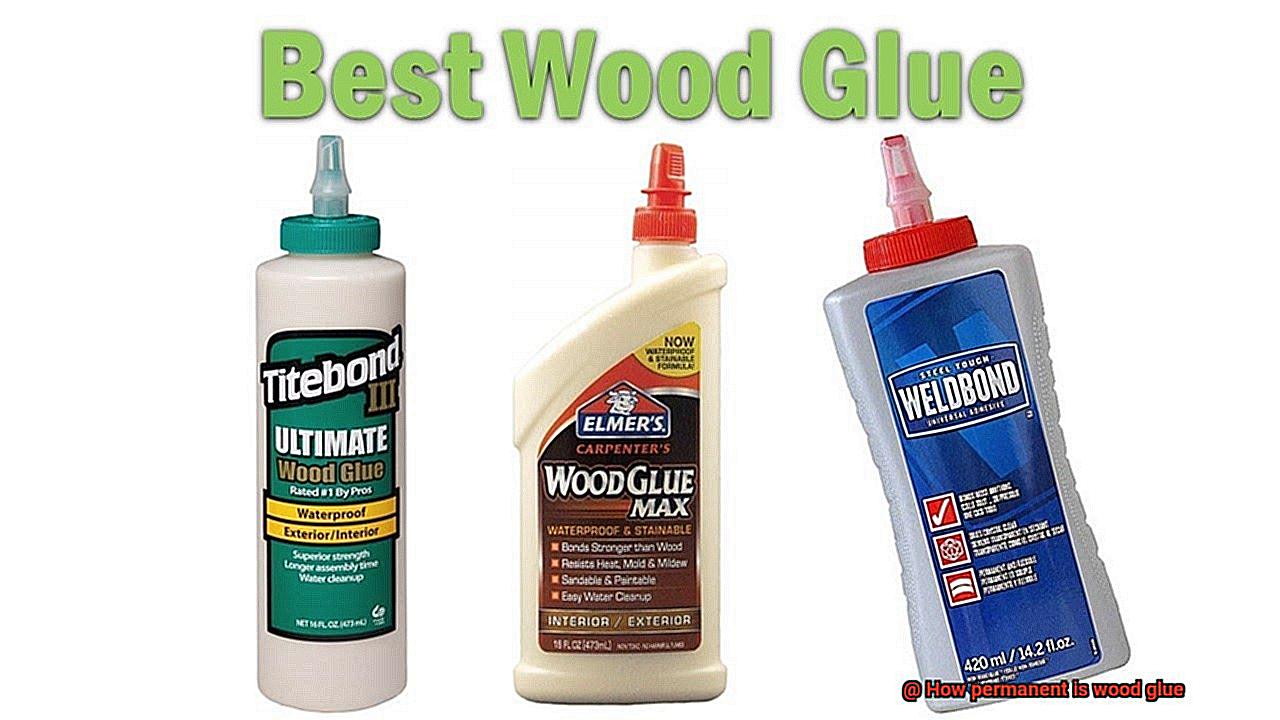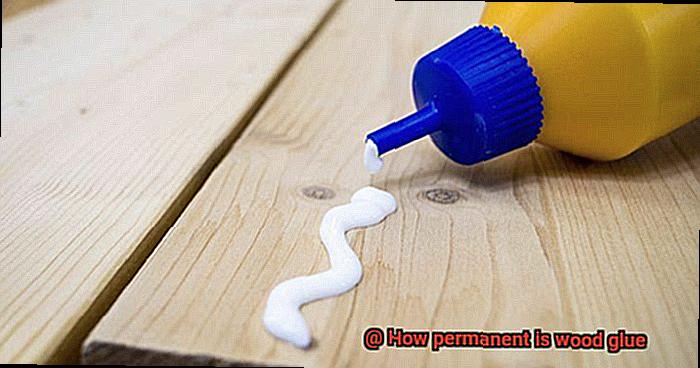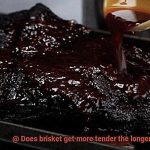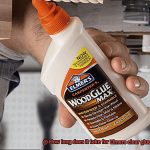Woodworking has been around for centuries, evolving from hand-carved stone tools to the use of power saws and drills. Despite these advancements, one thing remains constant: the importance of a strong adhesive to hold everything together. Wood glue is a popular choice among woodworkers, but how permanent is it really?
This question has plagued many woodworkers, especially those new to the craft. Unfortunately, there’s no simple answer as it depends on various factors such as the type of wood used, temperature and humidity levels, and the type of glue applied.

In this blog post, we’ll explore the world of wood glue in-depth to determine its permanence. We’ll examine different types of glue available in the market and their strengths and weaknesses. Additionally, we’ll discuss how long you can expect them to last so that your creations can stand the test of time.
So if you’re a woodworking enthusiast looking to make sure your projects endure for years to come, keep reading to find out just how permanent wood glue really is.
What is Wood Glue?
Contents
- 1 What is Wood Glue?
- 2 Types of Wood Glue
- 3 Factors Affecting the Permanence of Wood Glue
- 4 How to Create a Strong and Permanent Bond with Wood Glue
- 5 Pros and Cons of Different Types of Wood Glue
- 6 Tips for Ensuring a Long-Lasting Bond with Wood Glue
- 7 Common Mistakes to Avoid When Using Wood Glue
- 8 Alternatives to Wood Glue
- 9 Conclusion
Wood glue is a game-changing adhesive that no woodworking project should be without. It’s perfect for a wide range of projects, from building furniture and cabinetry to making repairs around the home. But what exactly is wood glue and how does it work its magic?
Also known as carpenter’s glue or PVA glue, wood glue is a water-based adhesive made from a polymer emulsion. This makes it less toxic than solvent-based adhesives and easy to clean up. What sets wood glue apart is its ability to penetrate the porous surface of wood, creating a bond that is stronger than the wood itself.
There are several types of wood glue available, each with unique properties and uses. Here’s a rundown of the most popular types:
- White glue: This is the most commonly used type of wood glue, ideal for indoor projects.
- Yellow glue: More water-resistant, yellow glue can be used for outdoor projects.
- Polyurethane glue: This type of glue expands as it cures, filling gaps in wood joints and creating an incredibly strong bond.

While wood glue is generally considered to be a permanent adhesive, there are factors that can affect its permanence. The type of glue used, environmental conditions, and quality of the bond created all play a role in the strength and durability of the bond.
To ensure maximum strength and durability, it’s essential to choose the right type of glue for your project and take proper precautions when applying it. Properly preparing the surfaces being bonded, using the right amount of glue, and allowing enough time for the glue to dry and cure are all essential steps in creating a strong and permanent bond.
Types of Wood Glue
When it comes to woodworking projects, the right type of wood glue is crucial for a strong and lasting bond. With so many options available, it can be challenging to know which type of glue to use. Let’s explore the different types of wood glue and their unique characteristics.
PVA Glue
Polyvinyl acetate (PVA) glue is the most popular type of wood glue. Its water-based formula makes it easy to clean up and dries clear, creating an unobtrusive bond between surfaces. PVA glue is best used on porous materials like wood, paper, and fabric. It creates a strong bond that is water-resistant but not completely waterproof, making it ideal for indoor projects.
Epoxy Glue
Epoxy glue is a two-part adhesive that consists of a resin and a hardener. When combined, they create a chemical reaction that results in a durable and waterproof bond. Epoxy glue can be used on various materials, including wood, metal, and plastic. Its strength and resistance to water and heat make it perfect for both indoor and outdoor projects.
Polyurethane Glue
Polyurethane glue is a one-part adhesive that cures when exposed to moisture in the air or substrate. It creates a bond that is resistant to water, heat, and chemicals, making it ideal for outdoor projects. As polyurethane glue expands as it dries, it’s perfect for filling gaps and cracks.
Hide Glue
Hide glue has been used by traditional woodworkers for centuries and remains popular today. It’s an animal-based adhesive made from collagen extracted from animal hides or bones. Hide glue has excellent holding power and can be easily reversed with heat and moisture, making it ideal for antique restoration projects.
Cyanoacrylate Glue
Commonly known as superglue, cyanoacrylate glue is a fast-drying adhesive that forms a strong bond in seconds. It works well on non-porous materials such as metal and plastic but may not be suitable for use on wood.
Factors Affecting the Permanence of Wood Glue
The permanence of that bond depends on several factors, and understanding these factors can make all the difference. So, let’s dive into the factors affecting the permanence of wood glue.
The type of glue you choose is a critical factor. Different types of adhesives have unique properties that affect their performance in different conditions. Polyvinyl acetate (PVA) glue is water-based and commonly used for bonding wood. It forms a strong bond but can be weakened by exposure to moisture or high humidity levels. On the other hand, polyurethane glue is ideal for outdoor use because it’s resistant to water, heat, and chemicals.
Application technique is another crucial factor to consider. Applying too little or too much glue can affect the strength of the bond. Proper application techniques ensure that the glue penetrates deep into the wood fibers, resulting in a strong bond. Additionally, allowing enough time for the glue to dry properly is essential to its permanence.
Environmental conditions also play a significant role in the permanence of wood glue. Moisture, humidity, and temperature can all impact how well the glue bonds to the wood. Exposure to moisture or high humidity levels can weaken the bond over time. Extreme temperatures can also cause the bond to weaken or even break altogether.
Here are some key takeaways:
- Choose the right type of adhesive for your project
- Use proper application technique
- Allow enough time for the glue to dry
- Store your project in an environment with stable temperature and humidity levels
How to Create a Strong and Permanent Bond with Wood Glue
Creating a strong and permanent bond with wood glue is essential for any woodworking project. The following tips will help you achieve a bond that will last for years.
Preparation is key
Before applying any glue, ensure that the surfaces to be bonded are clean, dry, and free of any dirt or debris. Sanding the surfaces can also help create a better bond by providing a rougher surface for the glue to adhere to.
Choose the right type of glue
There are many different types of wood glue available, each with its own set of strengths and weaknesses. For example, PVA glue is great for general woodworking projects, while epoxy glue is better for heavy-duty applications.
Apply the glue correctly
When applying the glue, spread it evenly over the entire surface to be bonded. Applying too much or too little glue can weaken the bond. A good rule of thumb is to apply enough glue so that it squeezes out slightly when you clamp the pieces together.
Clamp the pieces together
Once you have applied the glue, clamp the pieces together using a sufficient amount of pressure to ensure a strong bond. If you don’t have clamps, you can use weights or heavy objects to hold the pieces in place. Follow the manufacturer’s instructions for curing times.
Sand away excess glue
After the glue has dried, sand away any excess glue on the surface. Excess glue can create bumps or uneven spots on your project, which can be challenging to remove later on.
Pros and Cons of Different Types of Wood Glue
When you invest time and effort into a woodworking project, you want to ensure that it will last for years to come. Selecting the right type of wood glue is crucial to achieving this goal. Here are the pros and cons of four different types of wood glue:
PVA Glue:
PVA (Polyvinyl Acetate) glue, also called white glue, is a popular choice for woodworking projects due to its ease of use and quick drying time. It creates a strong bond that can withstand moderate stress and strain.
One advantage of PVA glue is that it has a relatively long open time, which means you have more time to make adjustments before it dries. However, PVA glue is not waterproof and can weaken when exposed to heat and moisture.
Polyurethane Glue:
Polyurethane glue, such as Gorilla Glue, is a versatile adhesive that can bond different materials, including wood, metal, and plastic. It expands as it dries, filling gaps and creating a strong bond.
One of the main advantages of polyurethane glue is its waterproof nature, making it ideal for outdoor projects that are exposed to moisture and temperature changes. However, it dries with a foamy texture that may require sanding or trimming.
Epoxy Glue:
Epoxy glue is a two-part adhesive that creates a strong and durable bond on various surfaces, including wood, metal, plastic, and glass. It can withstand exposure to heat, moisture, chemicals, and solvents. Epoxy glue is ideal for industrial applications where strength and durability are crucial factors. However, it requires precise mixing ratios and can be challenging to remove once it has dried.
Hide Glue:
Hide glue is an animal-based adhesive that has been used for centuries in woodworking projects. It creates a strong bond that can withstand moderate stress and strain. One advantage of hide glue is that it can be reversed with heat and moisture, allowing for easy repairs and adjustments. However, it requires a longer drying time and is not suitable for outdoor projects.
Tips for Ensuring a Long-Lasting Bond with Wood Glue
One crucial aspect of achieving this is to create a strong and permanent bond with wood glue. Here are some tips to help you achieve just that.
Choose the Right Type of Glue
Different types of wood glue have unique properties that make them suitable for specific applications. For example, PVA glue is great for general woodworking projects, while epoxy is better for joining two different types of materials. Choose the right type of glue based on your project’s needs to ensure a long-lasting bond.
Prepare the Surfaces Properly
Before applying glue, ensure that the surfaces are clean, dry, and free from any dust or debris. Any paint or varnish on the surface should be removed before gluing to ensure proper adhesion. Properly preparing the surfaces ensures that the glue adheres well and creates a strong bond.
Apply the Right Amount of Glue
Applying too little or too much glue can affect the strength of the bond. Ensure that you apply enough glue to cover the entire surface evenly without overdoing it. A thin but even layer of glue is enough to create a strong bond between the two surfaces.
Clamp the Wood Pieces Together
Clamping the wood pieces together after applying glue ensures that there is enough pressure on the joint to create a strong bond. Ensure that the clamps are tight and secure during the drying process, which helps to ensure complete penetration of the glue into the wood fibers.
Allow Enough Time for Drying
Drying time varies depending on the type of glue used, but it’s essential to allow sufficient time for the glue to dry completely before removing clamps or using the project. Rushing this step can weaken the bond and compromise your project’s longevity.
Common Mistakes to Avoid When Using Wood Glue
However, even the most experienced woodworkers can fall victim to common mistakes that can compromise the effectiveness of the glue. In this article, we’ll take a closer look at some of the most common mistakes to avoid when using wood glue, so that you can achieve optimal results for your woodworking projects.
Firstly, one of the most frequent mistakes people make is not adequately preparing the surfaces that will be glued together. This step is crucial since any dirt, dust or debris on the surface can weaken the bond. To prevent this, always make sure to clean and dry the surfaces beforehand.
Another common mistake is using too much glue. While it may seem logical to use more glue for a stronger bond, it’s actually counterproductive. Too much glue can result in gaps in the bond and weaken it over time. Use just enough glue to cover the surfaces evenly with a thin layer.
In addition, insufficient pressure when clamping the pieces together after applying the glue is another mistake to avoid. It’s essential to apply enough pressure to ensure that the pieces are firmly pressed together, creating a strong and permanent bond. Leave the pieces clamped together for a sufficient amount of time as indicated on the glue bottle or instructions.
Lastly, choosing the right type of wood glue for your project is vital. There are various types of glue available, each with their own strengths and weaknesses. For instance, PVA (polyvinyl acetate) glue is excellent for general woodworking projects, while epoxy glue is ideal for bonding porous or uneven surfaces.
Alternatives to Wood Glue
There are several alternatives that offer different properties and levels of permanence to suit your project needs. Let’s explore the different options available.
Firstly, there’s epoxy – a two-part adhesive consisting of a resin and a hardener. When mixed together, it creates a strong bond that is resistant to water, heat, and chemicals. Epoxy is perfect for filling gaps and providing structural support in woodworking projects.
Polyurethane glue is another alternative to wood glue that expands as it cures, making it ideal for filling gaps and cracks in wood. It also boasts excellent water resistance, making it perfect for outdoor projects.
If you’re in need of a quick-drying option, look no further than cyanoacrylate glue, also known as super glue. However, be aware that this type of glue may not hold up well under stress and is not as durable as other options.
Finally, mechanical fasteners such as screws, nails, and dowels can also be used instead of or in conjunction with wood glue. They offer flexibility for disassembly and reassembly of projects but may not provide as strong a bond as adhesives.
Also Read: How To Glue Wood To Concrete Without Drilling?
Conclusion
In summary, wood glue is a tried and true adhesive that has stood the test of time in the woodworking industry. However, its permanence hinges on various factors, including the type of glue used, environmental conditions, and proper application techniques. It’s crucial to select the appropriate glue for your project and take necessary precautions during application to achieve maximum strength and durability.
The market offers several types of wood glue with unique properties and applications. PVA glue is perfect for indoor projects, while polyurethane glue boasts resistance to water, heat, and chemicals making it ideal for outdoor use. Epoxy glue is essential for heavy-duty applications where strength and durability are paramount.
To guarantee a strong bond with wood glue, surface preparation is critical. Applying an even amount of glue over the entire surface area and applying sufficient pressure during drying time when clamping pieces together are key factors in creating a lasting bond.
While wood glue remains popular among woodworkers, there are viable alternatives such as epoxy glue, polyurethane glue, cyanoacrylate glue or mechanical fasteners like screws or nails.






